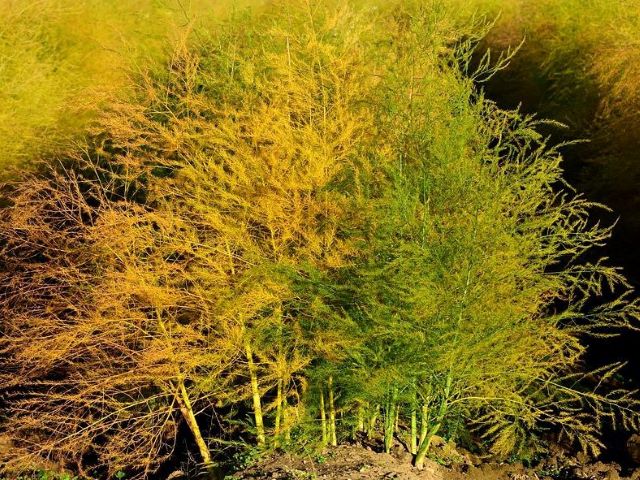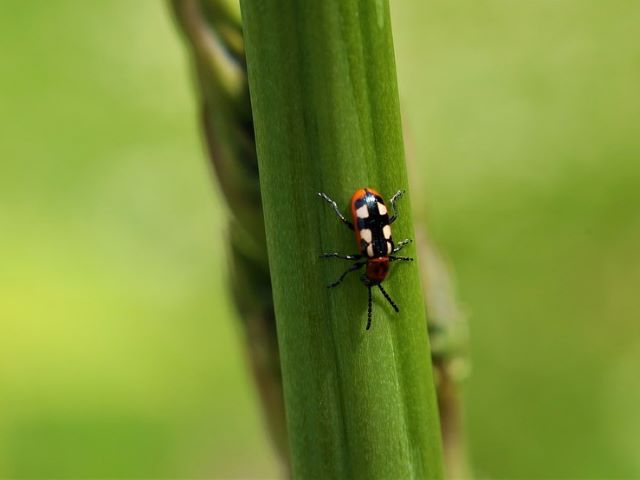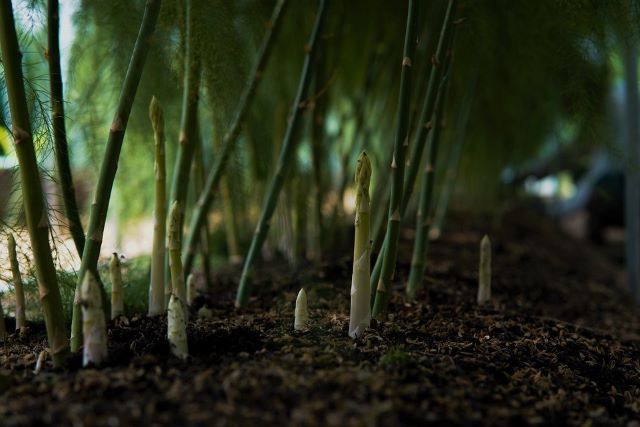Tender, sophisticated, and a seasonal star – asparagus can be a pride perennial in any gardener’s yard. But this delicious and sought-after crop can also need attention and care in order to truly flourish. So if your asparagus plant looks like it’s dying, this article is for you.

If you think your asparagus may be dying, some possible causes are pests, disease, lack of sufficient nutrients, or incorret water.
Let’s find out how to spot and remedy these asparagus growing problems. As well as tips to make sure your asparagus plants grow healthy, providing you with impressive harvests of tender spears year after year.
Table of Contents
Asparagus Plant Diseases
Asparagus can suffer from a number of soil and wind bourne diseases. All the more troubling because you want your asparagus plants to last years rather than just a season or two.
Here are some diseases that affect asparagus plants and if left untreated, can cause your asparagus plant to die. But catching these diseases early gives you the chance to minimize damage. And continue on to produce a thriving harvest of asparagus.
Asparagus Rust
Possibly the easiest to spot on the list, this fungal growth causes rust-colored spots to appear on the asparagus foliage. They can also appear yellow, reddish, or black depending on how they develop. And can eventually spread throughout the bed, bringing down your entire asparagus crop.
Take action as soon as you see the first signs of this disease on your asparagus plants. Cut down affected spears or ferns to the crown, then treat them with an antifungal mixture.
Some gardeners opt for using copper fungicide in small amounts. It’s worth bearing in mind that high concentrations of copper can be poisonous to plants and other organic life, so use sparingly.
For a more eco-friendly option, you can also try making your own anti-fungal mixture, by mixing 4 teaspoons of baking soda with water.
Pyrethrin leaves from the painted daisy flower can also be used. Dry the flower heads, grind them up, and mix them in around 4 gallons of water. After this has been strained through a tea cloth, you can apply it to the area you want to help guard against fungal growth.
To help prevent asparagus rust from becoming an issue at all, you can opt for disease-resistant varieties such as ‘Mary Washington’ when first planning your planting.
Asparagus Crown and Spear Rot
Also known as phytophthora rot, this is also most likely to affect asparagus beds in more humid weather or when the soil is overwatered. Soft spots may appear on spear tips and shoots, resulting in asparagus spears then becoming soft, wilted, or pale.
Regrettably, this often requires a ‘dig and destroy’ approach to affected asparagus plants, in order to prevent the rot from spreading.
The upside is that, when it comes to prevention, your asparagus plants are far less likely to be affected by this particular form of disease if they are positioned in full sun with well-draining soil.
Also, ensure you keep a good amount of space between your asparagus plants for airflow. And remove any weeds from the bed regularly.
Purple Spot
Another fungal disease that you can try to prevent, though not eradicate, using bought or homemade fungicides. Purple spot causes sunken lesions that turn brown or tan coloured on the asparagus spears. As these expand, they can end up killing the affected plant.
If using fungicide, try applying in the summer or early fall. This particular version of fungal growth often first appears in the cooler months.
Trying to ensure your asparagus plants are not over watered or crowded. Removing infected asparagus plants as soon as possible, can reduce the risk of the disease developing as well as limit the resultant damage.
Asparagus Root Rot
Conversely, this disease usually develops in dry, arid conditions rather than in humid ones.
Root rot is a result of the asparagus plant being weakened through drought. It is a disease that can often lie dormant in soil for decades, only emerging when conditions are right. It tends to affect the lower stems and root systems of asparagus and other plants, hence its rather ugly name!
Strong, well fed, and properly watered asparagus will always be better placed at keeping root rot away.
Asparagus Beetles

Though there are a number of critters that like to dine on asparagus before we humans get a chance to, none has quite the same voracious taste for the plant as the asparagus beetle.
This blue-black bug with its dark green larvae will merrily chomp through asparagus leaf and stem if left unchecked. And with the asparagus being a perennial plant it can offer these garden dwellers a reliable food source for years!
The best, least environmentally harmful way of dealing with asparagus beetles is simply removing them by hand with the aid of a water hose.
As long as you spot them relatively early, this should be enough to limit any burgeoning infestations. For larger infestations, horticultural neem oil can be effective in keeping them off your asparagus plants.
You can also, to try to reduce the population of beetles overwintering in your late fall foliage. You can do this by destroying any old asparagus stems that are left at the end of the season.
As with most garden bugs and insects, asparagus beetles are part and parcel of a healthy ecosystem. Even if they might cause issues for you as an asparagus gardener.
The best natural way of keeping insects in check is to ensure your garden area is as biodiverse as possible. Enable natural predators such as wasps, ladybugs, and birds to balance out other populations that feed on your plants.
Soil Quality and Nutrients for Asparagus
If bugs and disease aren’t causing your asparagus to struggle, but it’s still looking weak and withered, it could be that the soil itself isn’t giving it the food it needs.
Asparagus, like many perennials, is a hungry member of the garden. It needs consistently fertile, nutrient rich soil in order to do its best. Asparagus will set out roots early in its life cycle, developing a relatively deep system by the time it has settled and is ready to start providing you with a harvest.
In order to keep your soil properly nutrient-rich, apply a general purpose organic fertilizer roughly twice a year. When you first plant your crowns, ensure the area has been properly dug through with rich compost. And that it has been sufficiently weeded.
Asparagus plants don’t like competition and do best when they have the bed all to themselves!
Continue weeding throughout the asparagus’ life cycle and particularly in its early years.
It’s also worth putting down organic mulch when possible, particularly at the end of winter. This will help suppress competitive plants as well as gradually feed the soil with nutrients.
Because asparagus crowns gradually migrate upwards over the course of the plant’s life, it’s important to make sure that your soil is being topped up.
Asparagus crowns and root systems need to be properly covered in soil in order for the plant to survive and flourish. So ensure you’re topping up your bed with fresh compost of around 3 to 5 inches of soil above the main root crown.
Incorrect Watering of Asparagus
Asparagus can be a little delicate when it comes to getting moisture levels right. We’ve already seen how various diseases are encouraged by overly soggy or poor draining soil. As well as a few that can be encouraged by drought as well!
Gardeners often worry about whether or not we are watering our asparagus plants too much. Or too little. And it can feel like a difficult balancing act sometimes.
A good rule of thumb is to test the soil using your hand by scratching the soil an inch or two below the surface. (Or use a moisture meter like this one). If the soil is completely dry, you can go ahead and water it.
Otherwise, if there’s residual dampness in the topsoil layer, avoid applying any more water for the time being. Especially if the season you’re in isn’t particularly dry.
To help ensure your asparagus plants aren’t kept in damp soil, plant them in well-draining soil that also gets full sun.
Although asparagus can survive in dappled shade, it does better out in the open. And the exposure will also help to ensure rainfall drains and evaporates off more swiftly.
Asparagus Wilting or Falling Over
If you find your asparagus plant toppling over late in the season, this isn’t necessarily a sign that it’s dying!
Asparagus plants, especially if they continue to grow into maturity, can reach 4 or 5 feet (1.2-1.5 meters) tall. At which stage they can become top heavy and keel over.
Remember, asparagus is a perennial plant that grows from the root system. So having collapsing foliage due to weight is not necessarily an issue. Just clear away the collapsed foliage and allow the plant to regenerate for the next seasonal cycle.
If it looks as if your asparagus plant is growing too fast, too soon in the season, and is toppling over before you want it too, you can try staking it. Have it rest against a trellis, or clip it back.
Keep in mind, asparagus plants need their long stems and leafy ferns in order to gather energy for their root system. This in turn leads to future growth and spear development.
Fast foliage growth, particularly upwards, can also be a sign that your asparagus plant is not getting enough sunlight.
Poor Asparagus Harvests
Although it might not be a life or death scenario, it can still be disappointing if your asparagus isn’t producing the harvest you want it to. Any of the above factors can also lead to poor growth rather than plant death.
Additionally, it is also important that your asparagus is given the chance to establish itself properly before harvesting begins. This is why common advice is to leave your asparagus alone for a year after you first plant the crowns. And two years if you are planting from seed.
Once you begin harvesting asparagus spears in the second or third seasonal cycle, try to restrict your harvest to only a couple of weeks in the early years.
As the asparagus plant develops, you can gradually extend your harvesting period to between 6 and 8 weeks.
Leave some spears though. Asparagus plants needs them to grow and flourish into healthy ferns, in order for the plant to soak up the energy needed for future harvests.
Taking all the spears for yourself too early on can hinder the asparagus’ ability to expand and properly establish itself in the bed. Remember, it’s a perennial, one that, in the right conditions, can keep going for 30 years or more.
When it comes to harvesting and keeping asparagus healthy, you’re playing a long game. Not rushing to grab as much food as you can in the first few seasons.
Asparagus Growing Tips

When first planting asparagus, always opt for a fresh bed with new soil. Not a garden bed that has grown asparagus before. This can help to reduce the chance of old diseases and pests being carried over into the new planting environment.
You will need a well-drained soil with a neutral pH and full sun.
Dig the soil well to a depth of 12 inches (30 cms) and then add some compost and a thin layer of bone meal. It is quickest to grow plants from crowns and these can be planted six inches deep (15 cms) in the spring. They should be spaced at 18-to-24-inch (45 to 60 cms) intervals in rows 24 inches (60 cms) apart.
Ensure your asparagus is not overwatered. Over-watering or too much moisture in the soil can be a contributing factor to a number of fungal rot problems.
The secret lies in not harvesting all of the spears in the early stages. These need to be allowed to grow to supply chlorophyll to the root ball so that it can become established. Don’t harvest anything in the first year. The year after that harvest for just two weeks.
Once the asparagus plant is established, you can harvest the spears for up to two months. And the asparagus plant will go on to produce for as long as 30 years or more. Commercial producers tend to replace their plants every ten years as they find yields deteriorating after that.
Finally, when choosing crowns or seeds to plant, opt for disease-resistant varieties that can stand up to some of the most common problems out there.
Further reading:
